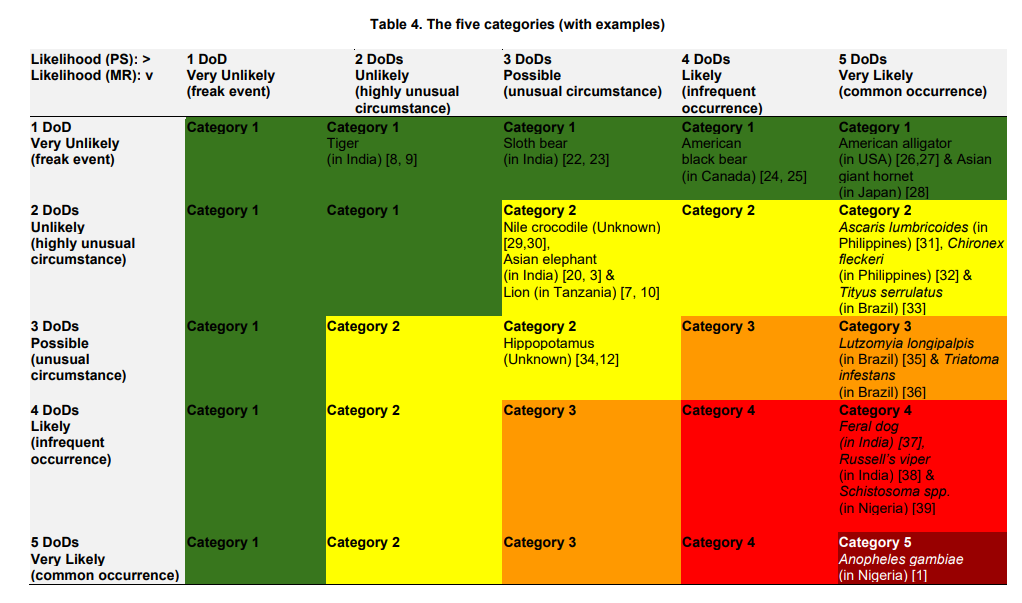Humankind shares the planet with all sorts of weird and wonderful creatures, from rare deep-sea mysteries, to black wolves, and tiny insects. Some of the species run into conflict with humans from time to time, whether through direct attacks or the spread of disease. Efforts to rank the most deadly are widespread, and now a new method has entered the chat. We take a deep dive into the Crespo Scale.
ADVERTISEMENT GO AD FREE
“The Crespo scale is a scale that ranks the ‘danger’ of an animal species based on how much of a threat it presents towards a random individual in a given country,” writes author David Duarte Crespo in the paper. The Crespo Scale ranks animals based on two main factors: population size (PS) and mortality rate (MR). PS accounts for the probability of someone encountering a dangerous animal in a specific country. MR is created by dividing the global population (8 billion) by the maximum estimated number of fatalities caused by a particular species per year.
“I chose to just use two factors for the scale because they’re universal – they can be applied to pretty much any animal species – and they’re measurable. You can measure (or at least estimate) things like how many people a species kills or how many of them there are; you can’t measure how aggressive or territorial it is,” Crespo told IFLScience.
Even though most of the results were roughly as expected, there were a few surprises that caught my attention.
David Duarte Crespo
Domesticated animals were excluded from the study due to their prevalence around humankind. “These are the animals that we spend the most amount of time with and they’re some of the ones most likely to kill you, especially if you live in a western country. So to avoid this bias, I didn’t include them. I also didn’t include human beings themselves for obvious reasons,” explained Crespo.
The numbers representing PS and MR are then divided or multiplied by five points called Degrees of Danger (DoDs). One DoD is “Very Unlikely” while 5 DoDs are “Very Likely”. They are then multiplied together to get the total. The maximum number of DoDs is 25, and this will determine into which category an animal is put. The scale then places the animals in a 1-5 system, where 5 is considered Very High Danger and 1 is Low Danger. Categories 3-5 are considered significant threats.
Animals are only included in the table when there is enough data for the species to be used. Interestingly the most dangerous animals for categories 3-5 are typically found in low- and middle-income countries, according to the Human Development Index. Most of the animals presented in the study that pose the largest threat are carriers of diseases, or are parasites, with the exception of the Russell’s viper (Daboia russelii).

Only species with enough data can be included in the scale.
“Since there’s a lot of data lacking, it meant I could only include species that I found enough data for. Even still, there are a few holes. An example is not knowing which African country is facing the most attacks and deaths by Nile crocodiles,” explained Crespo.
Given the nature of the scale, this means that categories that species are placed in can change between countries including that of the most dangerous species, the mosquito (Anopheles gambiae). This is a category five species in Nigeria, but category four in Mozambique.
“Even though most of the results were roughly as expected, there were a few surprises that caught my attention,” said Crespo. “One that springs to mind is the Asian giant hornet being much lower on the scale, only being classed as a category one. I was expecting it to be ranked higher given the fact that it has a huge population as a colony insect and is native to many densely populated countries like Japan. It’s also ended up becoming an invasive species in recent years.”
Overall the biggest threats on the Crespo scale are mosquitoes, Russell’s viper, blood flukes, and feral dogs, but with this method of categorizing the species, it really depends on where you live.
ADVERTISEMENT GO AD FREE
The paper is published in the Asian Journal of Research in Zoology.
Source Link: Want To Know The Most Dangerous Animal In The World? Ask The Crespo Scale